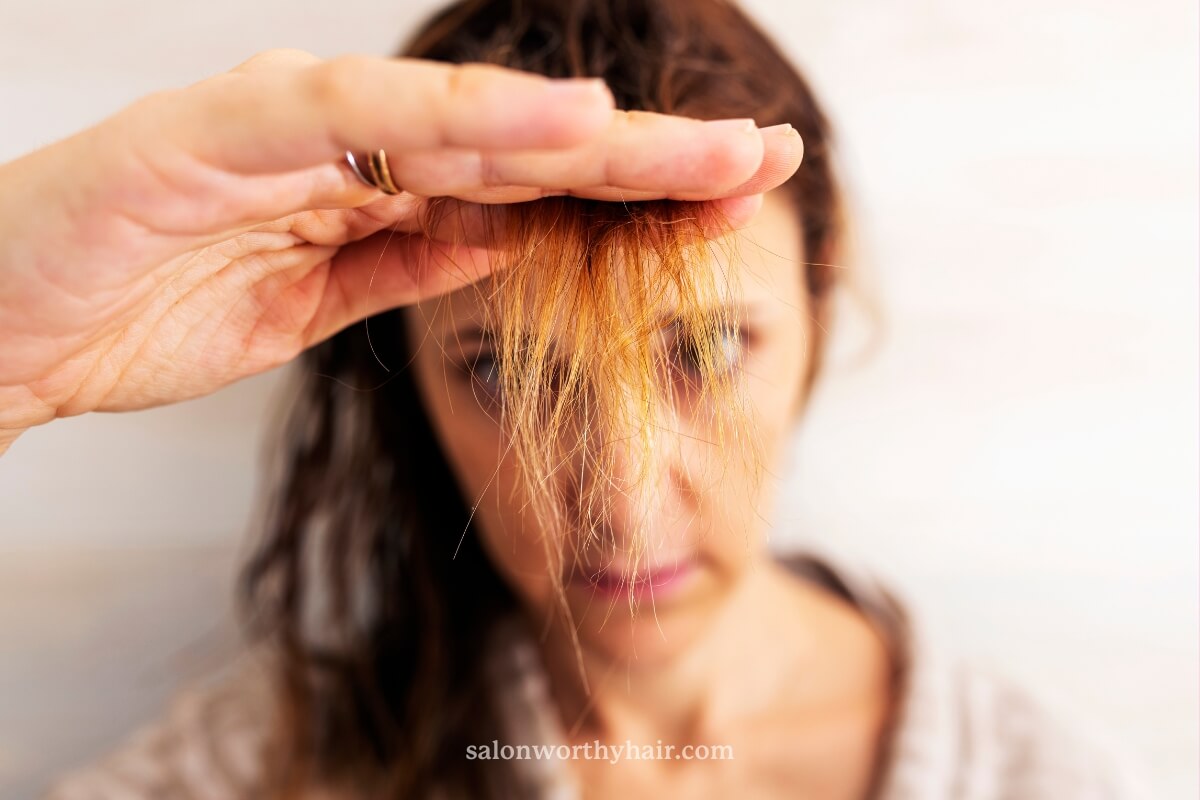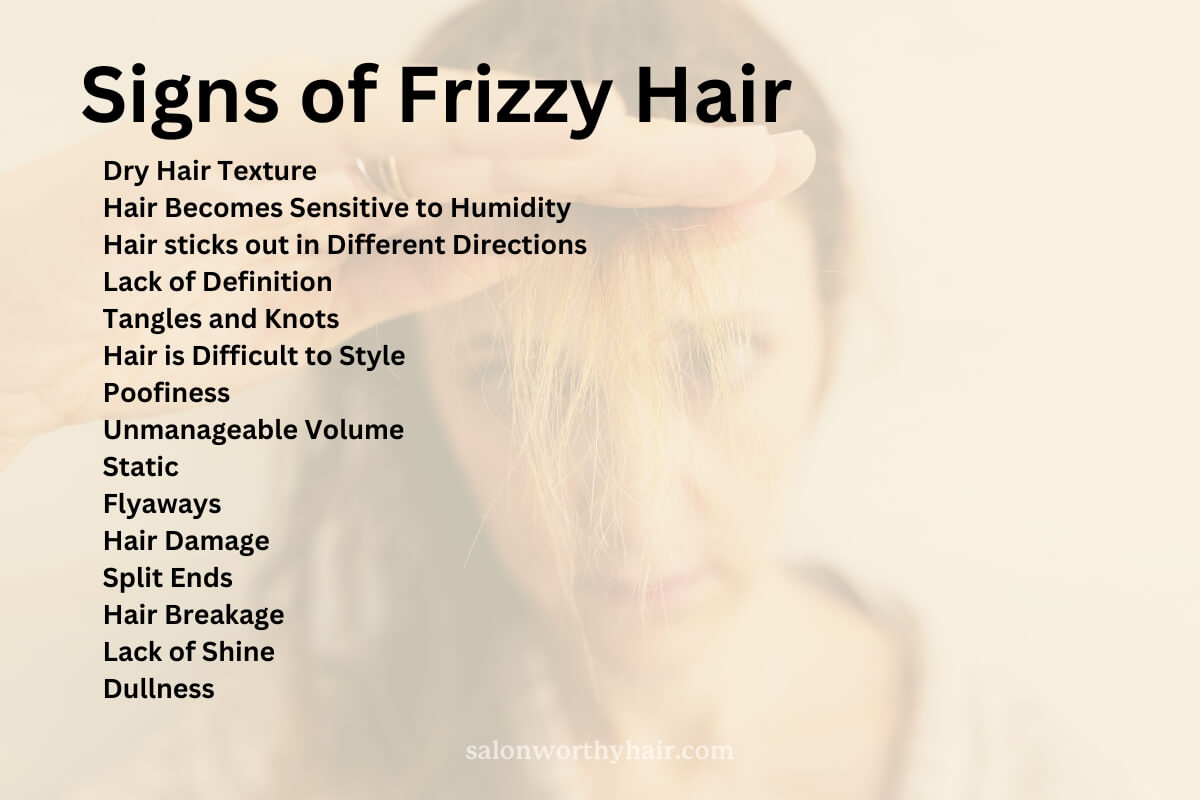Signs of Frizzy Hair: Dryness, Lack of Definition, Inconsistent Patterns
Updated on
This post may contain affiliate links. As an Amazon Associate, we may earn from qualifying purchases.

Frizz is the result of hair lacking moisture due to its raised cuticle layer, leading to a rough texture and lack of definition.
That’s why the main sign of frizz is often dry hair texture.
But since everyone’s hair is different, frizz can look different for each person. For example: frizz can manifest as hair that is sensitive to humid weather, appear as hair strands sticking out in different directions, cause lack of curl definition, make the hair tangle easily, and make hair difficult to style and manage by taking on a voluminous and poofy appearance.
Spotting these signs early can help you keep frizz under control and make your hair more manageable.
Here is a list of the signs of frizzy hair to watch out for:
- Hair feels dry in texture.
- Hair is sensitive to humidity.
- Hair strands stick out in different directions.
- Lack of curl definition.
- Hair tangles easily.
- Hair is difficult to style.
- Hair tends to look poofy.
- Unmanageable hair volume.
- Hair is prone to static electricity.
- Flyaways.
- Hair appears damaged.
- Hair has lots of split ends.
- Hair breakage.
- Hair looks dull.
- Hair lacks shine.

1. Frizzy Hair Has Dry Texture
Frizzy hair feels dry in texture due to lack of moisture. Running your fingers through the hair may expose tangles and knots, as the rough texture causes the strands to catch and snag. The hair might also feel stiff and coarse. Unlike smooth and hydrated hair, frizzy and dry hair lacks flexibility and elasticity.
When hair lacks moisture and becomes dry and frizzy, its elasticity diminishes. The loss of elasticity in frizzy hair means it cannot handle stretching or manipulation, therefore resisting efforts to be tamed and styled. On the other hand, healthy hair is adequately moisturized and has a natural elasticity that allows it to withstand the daily wear and tear of styling. The adequate moisture comes primarily from the scalp’s natural oil (sebum), which can coat and lubricate the hair strands from root to tip, and from external sources like moisturizing products. Having a healthy cuticle layer means the hair is effectively sealed, preventing moisture from escaping and external elements from damaging the hair shaft. This cuticle layer is a protective barrier that retains moisture, resulting in smoother, softer, and more flexible hair.
Frizzy hair often has a damaged or lifted cuticle layer, leading to increased porosity, where the hair readily absorbs and releases moisture from the environment. High porosity makes the hair quickly absorb excess moisture from the air, causing the hair shaft to swell and become unruly.
2. Frizzy Hair Expands in Humidity
Humidity is the measure of the air’s moisture or water content. Higher humidity levels mean more moisture in the air, while lower levels indicate drier conditions.
In high humidity conditions, frizzy hair becomes susceptible to swelling and expanding due to its porous nature. As the air’s moisture content increases, the dry and porous hair strands rapidly absorb water molecules from the surroundings. This absorption causes the hair cuticles, usually raised and damaged in frizzy hair, to lift further, allowing even more moisture to penetrate the hair shaft. As the hair fibers swell, they lose their smooth alignment, resulting in hair sticking out and curling in different directions.
3. Frizzy Hair Sticks Out and Curls in Different Directions
Frizzy hair exhibits a lack of smoothness and orderly structure. The hair strands lose alignment and cohesion, causing them to stand out and curl in various directions independently.
Frizzy hair strands often refuse to align with the overall hairstyle, causing them to protrude awkwardly and creating a sense of disarray. The disorderly appearance creates a lack of consistency and sleekness, as the hair appears to have a mind of its own, refusing to follow the natural pattern of the rest of the hair or any predetermined hairstyle.
When the hair lacks a clear and defined pattern, it may not fall neatly into place or follow a predictable way. This inconsistency can create an irregular and unruly look, with some sections of the hair appearing longer or thicker than others.
The lack of hair alignment and consistent patterns add to the disarray and the untamed, chaotic appearance.
4. Frizzy Hair Lacks Definition
Frizzy hair lacks definition due to its unruly and disorganized nature. The absence of a clear pattern makes it challenging for individual strands to hold a distinct shape or style. When hair lacks definition, it appears messy, shapeless, and difficult to manage.
Without a clear or distinct shape, frizzy hair often appears as a mass of uneven curls projecting away from the main body of the hair.
The irregularness in frizzy hair’s texture and pattern also contributes to the lack of smoothness, making the hair strands easily intertwine and entangled.
5. Frizzy Hair Tangles Easily
Frizzy hair, due to its rough and dry texture, is prone to tangling easily. When the hair lacks sufficient moisture and the cuticle layer becomes lifted or damaged, the hair strands lose their smoothness. As a result, these irregular and rough surfaces catch and intertwine with adjacent strands, leading to knots and tangles.
Frizzy hair’s increased porosity also contributes to tangling, as it readily absorbs moisture from the surrounding environment. In humid conditions, the hair absorbs moisture from the air, causing the hair shaft to swell and become entangled with neighboring strands. Factors like excessive brushing, friction from clothing, and movements during daily activities can further exacerbate tangling in frizzy hair.
6. Frizzy Hair is Difficult to Style
The difficulty in styling frizzy hair extends beyond just tangles; it also struggles to hold smooth or sleek hairstyles. Attempts to straighten or smoothen frizzy hair can be met with resistance, as the hair resists being controlled due to its naturally rebellious and unruly nature. Heat styling tools may provide temporary relief, but the humidity in the environment can quickly undo the efforts, causing the hair to revert to its frizzy condition.
Moreover, the tendency of frizzy hair to look poofy further adds to the styling challenges.
7. Frizzy Hair Has the Tendency to Look Poofy
“Poofy hair” means hair with inflated, puffed up, and excess volume. It often involves thick hair types, where individual strands are naturally voluminous, resulting in a fuller and sometimes unruly appearance. This trait is most noticeable when the hair is not groomed or tamed, as it expands and creates a voluminous impression. When used to describe fine hair, the term “poofy” takes on a slightly different meaning. “Poofy” refers to fluffiness or lightness rather than excessive volume in fine hair.
Frizzy hair tends to poof out in a chaotic, haphazard manner because the raised cuticle scales trap air between the strands, making the hair appear bigger and increasing its volume. The chaotic increase in volume gives frizzy hair its characteristically “poofy” or “fluffy” appearance.
Several factors contribute to the poofiness:
- Separated hair strands due to raised cuticle scales that trap air.
- Hair strands sticking out at different angles instead of lying flat.
- Lack of definition between individual hair strands.
- Increased volume and bulk as the hair puffs out in a disorganized way.
- Hair appears bigger and loses its normally straight or wavy shape.
8. Frizzy Hair Can Have Unmanageable Volume
Frizzy hair can have unmanageable volume, making it appear larger and more voluminous than desired. The presence of frizz causes individual hair strands to stand out and create a halo effect around the head. This excess volume can be challenging to control and style, as the hair resists staying in place and may not hold its intended shape.
Individuals with frizzy hair may find traditional hairstyles, such as sleek and smooth looks, difficult to achieve and maintain. The excess volume can disrupt the intended style, creating a messy and untamed appearance.
Moreover, frizzy hair is prone to static due to the lack of moisture. When the hair is dry, it builds up an electrical charge, causing individual strands to repel each other. This static effect further contributes to frizzy hair’s voluminous and chaotic nature.
9. Frizzy Hair is Prone to Static
Static in hair occurs when the hair becomes charged with electricity due to a lack of moisture. Static electricity makes individual hair strands repel each other because of their like charges, leading to the characteristic “static” effect. The static effect cause hair strands to stand on end or stick together, resulting in an untidy and unruly appearance.
The dry and rough texture of frizzy hair creates an uneven surface that catches and holds onto charged particles. In dry environments or during colder seasons, static in frizzy hair can become more pronounced. Styling tools and synthetic fabrics can also contribute to the buildup of static in the hair through friction.
Friction occurs when hair surfaces move against each other or specific fabrics, resulting in various hair reactions. This dynamic interaction can sometimes lift the hair cuticles, leading to roughness and tangling. Certain fabrics, like wool or synthetic materials, are notorious for causing friction with hair. As your hair strands rub against the friction-causing materials, electrons from one strand are transferred to the other, creating a slight charge on the hair.
Moreover, static in frizzy hair can worsen the appearance of short, fine hairs that escape from the main hairstyle, also known as flyaways.
10. Flyaways Are a Sign of Frizz
Flyaways are individual hair strands that escape from the hairstyle and form unruly hairs that resist taming.
Frizzy hair with flyaways appears untamed and can lead to frustration during styling attempts. The lack of smoothness and control can make achieving sleek hairstyles or well-defined curls challenging. Moreover, flyaways can make the hair look unkempt, undermining a polished and put-together appearance.
11. Frizzy Hair Appears Frayed and Damaged
The visible fraying, looseness, lifting, and separation of individual strands that characterizes frizzy hair often indicate some level of damage – whether from split ends, hydration issues, protein loss, overuse of heat styling tools, dyes, and other chemical treatments can disrupt hair’s internal structure and natural lipid barriers.
When you look at damaged hair, the effects are more evident towards the end parts of the strands. Frayed tips become apparent as the hair fibers lose their protective cuticle layer, causing them to split into multiple smaller strands. Frayed and damaged hair showcases signs of distress, with frizz-like split ends and an overall lack of vitality.
12. Split Ends Can Be a Sign of Frizzy Hair
Split ends occur when the outer layer of the hair shaft (the cuticle) becomes damaged and splits, exposing the inner layer (the cortex). When this happens, a hair strand essentially forks into two or more smaller strands, causing the ends to fray.
Split ends can contribute to frizzy hair in several ways:
- The split strands stick out at different angles. Since split ends have split into multiple strands, these strands tend to stick out in different directions rather than lying flat and together like healthy hair. This separation of strands adds volume and a fuzzy appearance.
- Split ends absorb more moisture. When the cuticle layer is damaged, it loses its ability to seal in moisture. The lack of internal moisture causes dry split ends to absorb water from the air, causing them to swell and separate more easily – contributing to frizz.
- Split ends worsen with time. Without proper hair care and regular trimming, split ends tend to travel further up the hair shaft and multiply in number over time. This progressive damage leads to increasing frizz and “splittiness.”
- Split ends can travel up the hair shaft. As split ends move higher up the hair with brushing, styling, and natural growth, they can also cause other parts of the hair shaft to split, thus multiplying the frizz-inducing effects.
13. Frizzy Hair Tends to Be Prone to Breakage
Hair breakage leads to significantly shorter, frayed strands that stick out at uneven lengths. This disorganized, wispy appearance – strands breaking at different points along the hair shaft – signifies frizziness and damaged hair.
Hair breakage refers to the tendency of hair strands to snap or break rather than bending or stretching. Breakage leads to shorter, damaged hair and can contribute to frizziness.
Frequent breakage is caused by physical damage from excessive heat styling, harsh chemicals, tight braids/styles, and rough brushing or towel drying. Protein loss and internal structural damage also make hair prone to snapping.
Hair breakage results in shorter, jagged-edged strands that stick out at uneven lengths, contributing to a frizzy, wispy look. It’s common to see hair strands breaking when they have already begun to fray and split. As hair breaks, it becomes harder to style smoothly and tends to poof up more easily. The resulting frizz gives hair a dry and dull appearance.
14. Frizzy Hair Can Look Dull
Dullness refers to hair that appears flat, lifeless, and lacking shine or luster. Unlike healthy hair with a smooth cuticle layer reflecting light, frizzy hair has lifted cuticles that do not lay flat and reflect light. The disrupted cuticle layer disrupts the hair’s ability to reflect light, making it look dull and matte instead of shiny.
The relationship between frizz and dullness can be seen as part of a broader context where the appearance of hair reflects its overall health and the care it receives. When hair is nourished, properly hydrated, and protected from damage, it often appears shiny and vibrant. Conversely, when hair is mistreated or neglected, frizz and dullness can result, making it look less healthy and attractive.
15. Frizzy Hair Lacks Shine
Frizzy hair often lacks the sleek, glossy appearance or shine commonly associated with healthy, well-moisturized locks. This absence of shine might be due to various factors, including damage from over-styling, exposure to harsh environmental conditions, or a lack of essential oils and nutrients in the hair. As the cuticle layers of frizzy hair might be raised or uneven, they fail to reflect light uniformly, lacking that characteristic luster or shine seen in smooth and well-conditioned hair.
What Are the Causes of Frizzy Hair?
A combination of factors causes frizzy hair. Genetic predisposition might make some individuals more susceptible to frizz, but environmental conditions (like humid climate) and lifestyle choices can also play a significant role.
Ambient humidity, for example, can cause the hair cuticle to open up, absorbing excess moisture and leading to swelling and frizz. This effect is often compounded by heat damage from overuse of styling tools, which can break down the protein bonds that keep hair smooth and exacerbate the frizzy appearance. Over-processing through frequent chemical treatments can further worsen the condition, which may render the hair dry and brittle.
Additionally, inadequate hair care routines, such as using harsh shampoos or neglecting to use conditioner or serum, can strip the hair of its natural moisture. This lack of moisture can make the hair more prone to frizz, demonstrating the interconnected nature of these contributing factors.
Learn more about what causes frizzy hair.About the Author
 Shehnaz Shirazi
Shehnaz ShiraziShehnaz Shirazi has been writing in the beauty and cosmetics industry for over 8 years, sharing her expansive hair care and beauty knowledge. Shehnaz researches and tests new hair care trends and publishes her insights here.